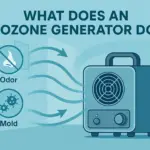Quick Answer: Ozone can help reduce the lingering smell of cat urine in the air and on surfaces, but it rarely fixes the root problem on its own. Cat urine contains uric acid crystals that bond into carpet padding, wood, and walls. Ozone freshens a room temporarily, but for lasting results you’ll need enzyme cleaners — and sometimes even carpet or padding replacement.
Table of Contents
Why Cat Odors Are So Hard to Remove
Cat odors aren’t just “stronger dog smells.” They’re chemically different. Cat urine is packed with uric acid crystals, and once those crystals seep into carpet padding, subfloor, or drywall, they’re tough to remove with normal cleaners. Every time humidity rises, the odor reactivates.
Cats also spray vertical surfaces like baseboards and furniture, driving odor deeper into the room. That’s why dog smells usually clean up easier, while cat odors seem to come back again and again.
Ozone Generators for Cat Odors: What to Expect
If you’re standing there ready to pull out your hair and thinking, “Maybe ozone is the shortcut,” here’s what to know.
Home ozone machines — the kind many people buy from brands like OdorFree, Enerzen, Airthereal, or O3 Pure — release ozone gas that reacts with odor molecules in the air and on surfaces. Used properly, ozone can noticeably freshen a room that smells like cat urine or litter box.
-
- Temporary relief: If the odor is surface-level, ozone can knock it down for days or weeks. But if urine has soaked into padding or wood, the smell usually creeps back.
- Safety first: People and pets must be out of the room during treatment. Afterward, ventilate thoroughly before re-entry.
- Watch out for overuse: Running ozone too long leaves a sharp, bleach-like smell that can irritate your lungs when you return.
If you’re treating a one-time pet odor problem, renting might be all you need. Here’s how to know whether to rent or buy an ozone machine
Can You Combine Ozone with Carpet Cleaning?
Yes — and this is the smarter way to use it. Think of ozone as a finishing step, not the first line of attack.
- Clean first: Use an enzyme cleaner made for cat urine (popular picks: Nature’s Miracle, Rocco & Roxie, Simple Solution). If you’re doing machine cleaning, units like Rug Doctor or Bissell Pet Pro pair well with an enzyme pre-treat.
- Run ozone afterward: Once the source has been treated or extracted, ozone removes lingering odor molecules in the air and on surfaces.
Running ozone before cleaning is like spraying air freshener — it hides the smell but doesn’t fix it.
Where Ozone Falls Short
Ozone does not dissolve uric acid crystals, and it can’t pull contamination out of carpet padding, subfloors, or drywall. If the source isn’t handled, the smell will keep coming back no matter how many cycles you run.
To Get the Smell Gone Right
Here’s a step-by-step plan most real people end up following:
- Find every spot: Use a UV/blacklight at night (common pick: Vansky UV Flashlight) to reveal urine stains and mark them.
- Soak with enzyme cleaner: Don’t just mist the surface — saturate it and give it time to work (24–48 hours, repeat if needed). Brands like Nature’s Miracle or Rocco & Roxie are formulated specifically for cat urine.
- Check the padding: If it still smells after enzyme treatment, the padding or even the carpet backing may need to be replaced; seal stained subfloor before reinstalling.
- Run ozone after cleaning/removal: This clears up remaining airborne odor and freshens the room. Home units like Enerzen or OdorFree are commonly used; pros run larger commercial machines.
- Prevent repeat issues: Keep litter boxes clean, consider a vet check for new spraying, and address territory/behavior triggers.
Ozone vs. Other Pet Odor Removal Methods
| Method | What It Does Best | Where It Falls Short | Best Use |
|---|---|---|---|
| Ozone Generator (OdorFree, Enerzen, Airthereal, O3 Pure) | Neutralizes airborne odors and surface smells; works fast in empty rooms. | Doesn’t dissolve uric acid crystals; effect is temporary if source remains; unsafe for people/pets during use. | Run after cleaning to freshen the room and knock down lingering odor. |
| Enzyme Cleaner (Nature’s Miracle, Rocco & Roxie, Simple Solution) | Breaks down uric acid crystals in cat urine; stops odor at the source. | Needs time (24–48 hours) and multiple treatments; may not reach deep into padding. | Treat fresh accidents or marked areas before considering ozone. |
| Steam/Hot Water Extraction (Rug Doctor, Bissell Pet Pro) | Flushes out surface urine and helps lift odors; pairs well with enzyme pre-treatment. | Can spread urine deeper if done without enzymes; not effective for heavy contamination. | Best for carpets after enzyme soak to remove residues and refresh fibers. |
| Replacement (Carpet/Padding/Subfloor seal) | Completely removes contaminated material; guarantees odor elimination. | Most expensive and labor-intensive; not always practical in rentals. | Last resort when odors have soaked into padding, subfloor, or drywall. |
When to Call a Pro
It may be time to call in professionals if:
- The smell is in subfloors, walls, or baseboards.
- Multiple rooms are affected.
- You’ve already tried enzyme cleaners and ozone without success.
Pros can pull carpet, replace padding, seal subfloors, and run commercial ozone cycles safely.
Ozone and Pet Odors FAQ
How long does ozone last on cat urine smells?
If the odor is only on the surface, ozone may give relief for several days to a few weeks. But if urine crystals are deep in padding, wood, or walls, the smell usually creeps back unless the source is treated with an enzyme cleaner or replaced.
Is ozone safe to use in a home with cats?
Yes — but only when the cat is not in the room. Ozone should never be breathed by people or pets. After running a generator, ventilate the space thoroughly before letting cats back inside.
Can ozone remove litter box smell?
Ozone can freshen the air around a litter box, but it’s not a substitute for scooping and cleaning. Daily scooping, weekly litter changes, and occasional enzyme sprays around the box area do the heavy lifting. Ozone is a finishing touch.
Will ozone get rid of dog odors too?
Yes. Ozone works well on wet-dog and kennel odors, especially when paired with cleaning. Dog urine typically binds less tightly than cat urine, so a combo of enzyme + ozone often works.
Ozone can remove strong smells, but it can’t kill hidden pests like bed bugs. Learn what actually works for infestations.
Is ozone safe if I keep birds in the house?
No. Birds have extremely sensitive respiratory systems. Even trace amounts of ozone can harm them. Relocate birds well away from the treatment area and air the home out fully before re-entry.
What about reptiles and small animals?
Reptiles, rabbits, guinea pigs, and similar pets should also be removed during ozone treatments. Ozone can irritate lungs and eyes — always err on the side of caution.
Can I run ozone after steam-cleaning carpets?
Yes — that’s one of the best times. Steam/hot water extraction (Rug Doctor, Bissell Pet Pro) or an enzyme soak attacks the source, and ozone helps neutralize the leftover airborne smells.
Alternatives and Everyday Odor Control
For everyday freshness, ozone isn’t practical. Instead, consider:
- HEPA + activated carbon air purifiers (e.g., Winix 5500-2, Levoit Core 400S) to continuously absorb litter box odors and dander.
- Baking soda sprinkled in litter boxes or on rugs as a cheap deodorizer.
- Regular litter maintenance — scooping daily and fully changing litter weekly.
- Enzyme sprays for spot treatments when accidents happen.
Bottom line: Ozone can freshen a cat-smelling room, but it’s not a silver bullet. Use it after you’ve treated or removed the source with enzyme cleaners, and you’ll get the best results. For deep-set odors, material replacement and subfloor sealing are often the only real solutions.




